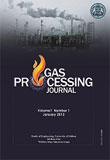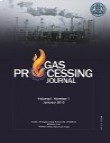فهرست مطالب

Gas Processing Journal
Volume:3 Issue: 1, Winter 2015
- تاریخ انتشار: 1394/03/11
- تعداد عناوین: 6
-
-
Page 1Advanced exergy analysis is a tool to split the exergy destruction of the system to achieve a better perspective about the potentials of a system for improvements. In addition, the component interactions and their exergy destruction dependency with the other equipment are investigated through the advanced exergy analysis. For this purpose, it divides the exergy destruction calculated by conventional exergy analysis, into endogenous/exogenous and unavoidable/avoidable. It can be concluded that the endogenous part has the most portion of exergy destruction in components. In other words, component interactions have minor effects on system irreversibility, except heat exchanger E-100, which is affected by the compressors position. Sensitivity analysis is carried out to study the effect of some system parameters on compressor consumption power and total exergy destruction of the system. Results show that lowering the feed temperature and raising the feed pressure, decrease the compressor power, and higher pressure ratio decreases the total exergy destruction. Optimization is also carried out to reduce the power consumption of the compressor and propylene cooler.Keywords: Exergy Analysis, Advances Exergy Analysis, Aspen HYSYS, Sensitivity Analysis, Optimization
-
Page 11The exergy analysis is a proper method for performance evaluation of industrial systems. A generic and detailed analysis of the GPCSs on the second gas pipeline of Iran is made by the means of exergy. The two main improvement measures of fuel pre-heating and steam injection technologies are presented for the current conventional stations. Steady state equations regarding the second law of thermodynamics and the chemical and physical exergy analysis are presented as well. The results indicate that the improved cycle is a more energy saving one, with an overall efficiency and net output power. The exegetic efficiency of every gas turbine of the improved station is increased by 31% in average and their exergy destruction is decreased by 84%. The amount of total exergy saving for the case study would be 552 MW. A higher overall efficiency can be achieved by an increase in both the turbine inlet temperature (TIT) and steam mass flow (SMF).Keywords: Gas Compression Stations, Steam Injection, Exergy Analysis, Exergy Destruction
-
Page 19Compressibility factor and viscosity of natural gasses are of great importance in petroleum and chemical engineering. To calculate the natural gas properties in the pipelines, storage systems and reservoirs, the exact values of gas compressibility factor and viscosity are required. A new method that allows accurate determination of compressibility factor and gas viscosity for all types of: sweet, sour, condensate and acid gases in a wide range of pressure and temperature conditions are presented here. The sizable data base of experimental Z factor and experimental gas viscosity measurements is collected from the available related literature. This newly developed method is tested by implementation of combined fuzzy inference system and Genetic Algorithm. The natural gas compressibility factor and viscosity as a function of gas composition, pressure, temperature and molecular weight of C7 can be predicted through this model. The accuracy of this proposed model is compared with some commonly applied empirical correlations. The average absolute relative error here is 1.28 % and 0.57% for Z factor and gas viscosity, respectively.Keywords: Natural Gas Viscosity, Gas Compressibility Factor, ANFIS, Genetic Algorithm
-
Polyvinylidene Fluoride Hollow Fiber Membrane Contactor Incorporating Surface Modifying Macromolecule for Carbon Dioxide Stripping from WaterPage 29Porous surface modified polyvinylidene fluoride (PVDF) hollow fiber membranes are fabricated through a dry-wet phased inversion process. Surface modifying macromolecules (SMM) (1 wt. %) are used as additives in the spinning dope. The performance of the surface modified membrane in contactor application for CO2 stripping from water is assessed through the fabricated gasliquid membrane contactor modules. It is found that the liquid phase resistance is dominant in the stripping flux experiments. The results indicate that the surface modified PVDF membrane out performs control PVDF membrane. By applying surface modified membrane in a CO2 stripping process at the liquid flow rate of 200 ml.min-1, the maximum CO2 stripping flux and efficiency of 1.78 × 10-3 and 65 % are achieved, respectively. Enhancement of gas flow rate increased the CO2 desorption flux, while this changing is negligible. By increasing the liquid temperature from 80 to 90 oC, the CO2 stripping flux increases from 1.78×10−3 to 2.18 ×10−3 mol.m-2.s-1 at 200 ml.min-1 liquid velocity. Consequently, the liquid phase temperature has a significant effect on the stripping flux in membrane contactor application. In a long-term stability study, CO2 stripping flux decreases about 16.4 % by using surface modified PVDF membrane during 130 h operation.Keywords: PVDF Hollow Fiber Membrane, Surface Modifying Macromolecule (SMM), Membrane Contactor, CO2 Stripping
-
Page 41Gas compressibility factor (z-factor) is an important parameter widely applied in petroleum and chemical engineering. Experimental measurements, equations of state (EOSs) and empirical correlations are the most common sources in z-factor calculations. However, these methods have serious limitations such as being time-consuming as well as those from a computational point of view, like instability, convergence and accuracy. Accurate and fast estimation of this parameter is of interest and a challenging factor in the numerous calculations related to oil and gas processing plants. In this study, a meta-learning algorithm named multi-gene genetic algorithm (MGGP) was applied to predict the sweet gas compressibility factor. To assess the effectiveness of the MGGP model statistical criteria, is applied. The validity of this proposed model was compared with the experimental data. The results showed that the model has successfully predicted the sweet natural gas z-factor, especially at the midrange of operating conditions. However, the MGGP model seems to be inefficient in boundary values of Tpr (i.e. around 1 and 2). In addition, the MGGP model is compared with other z-factor correlations and it is revealed that the implementation of MGGP model lead to a more accurate and reliable estimation of the natural gas compressibility factor.Keywords: Natural gas, Compressibility factor, Multi, gene genetic programming, correlations
-
Page 51Exergy analysis and response surface methodology (RSM) is applied to reduce the exergy loss and improve energy and exergy efficiency of acetic acid production plant. Exergy analysis is run as a thermodynamic tool to assess exergy loss in reactor and towers of acetic acid production process. The process is simulated in Aspen Plus(v.8.4) simulator and the necessary thermodynamics data for calculating exergy of the streams is extracted from the simulation. By applying exergy balance on each one of the equipment, exergy losses are calculated. Response Surface Methodology (RSM) is a well-known statistical optimization method adopted in optimizing and modeling chemical processes, and operational parameters in reactor and towers. In this optimization framework the objective is to minimize exergy loss as objective function, subject to engineering and operational constraints. One of the modifications made on the reaction section is consumption of hot effluent stream from the reactor to produce steam. This modification prevents wasting the generated heat in the reactor and leads to improving exergy efficiency in reactor. All tunable operation parameters regarding reactor and towers and their upper and lower limits are specified and optimized through the RSM method. As a result, by optimization, exergy loss is reduced by 11365.8 Mj/hr and 2496.1Mj/hr in reactor and towers, respectively.Keywords: Acetic Acid, Exergy analysis, Exergy loss, Optimization, RSM method


